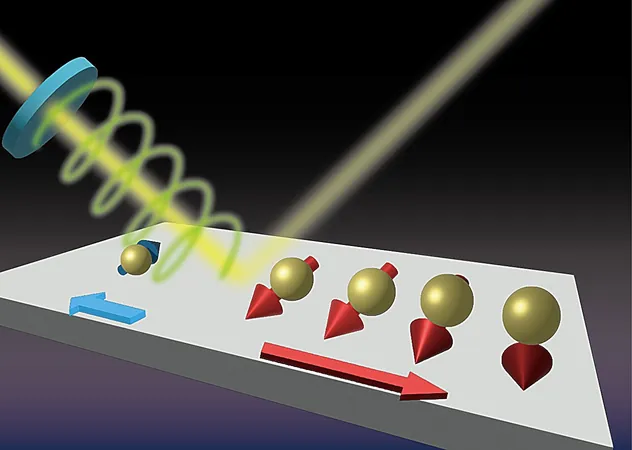
Revolutionary Discovery: Single-Atom Metal Layer Unleashes New Potential for Spintronics with Light Control!
2025-01-10
Author: Emma
Breakthrough in Spintronics
In an astonishing breakthrough, researchers from the University of Tokyo have unveiled a groundbreaking method to control spin-polarized current using a single-atom layer of a thallium-lead alloy. This discovery shakes the foundations of conventional materials science by demonstrating that, contrary to prior beliefs, single-atom layers can exhibit significant interaction with light, contradicting the notion that they are merely transparent to light.
Enhanced Functionality Beyond Traditional Diodes
The experiment reveals that the spin-polarized current can be directed in one specific path, offering functionality far beyond what traditional diodes can achieve. This development heralds a promising future for sustainable data storage solutions, potentially leading to the creation of ultra-fine two-dimensional spintronic devices. These innovations could revolutionize the electronics industry, making devices faster and more energy-efficient.
Challenges in Modern Electronics
While diodes are essential components in modern electronics—allowing current to flow in only one direction—the challenge of creating thinner components has often complicated their design and manufacturing processes. This study, published in the renowned journal ACS Nano, shines a spotlight on the emerging field of spintronics, which seeks to leverage the intrinsic angular momentum, or spin, of electrons by utilizing light to manipulate them.
Insights from Researchers
Lead researcher Ryota Akiyama emphasized the significance of exploring thinner materials: "Traditionally, spintronics dealt with thicker materials, but we were captivated by the unique properties of very thin systems. Our goal was to merge the manipulation of light with the generation of spin-polarized currents in a two-dimensional setting."
Understanding the Circular Photogalvanic Effect
The phenomenon they explored, known as the circular photogalvanic effect (CPGE), allows for the conversion of light into spin-polarized current. In this state, the spins of electrons align in a single direction, enabling the current to flow unidirectionally based on the polarization of the incoming light. This is strikingly similar to how conventional diodes restrict electrical current flow.
Experimental Techniques and Findings
To investigate this remarkable effect, the researchers utilized ultra-thin thallium-lead alloys and conducted experiments in an ultra-high vacuum environment, ensuring the purity and integrity of their material. Upon exposure to circular polarized light, variations in both direction and intensity of the current were meticulously observed.
Unexpected Outcomes
Akiyama noted, “What was even more unexpected was the occurrence of a spin-polarized current, where the electron spin is aligned with the flow of the current. This was made possible due to the unique properties inherent in these thin alloys."
Future Prospects
These thin alloys, previously developed by the research team, possess electronic characteristics that guided the current research. Looking ahead, Akiyama expressed optimism about future explorations: "Our findings underscore the importance of foundational research for technological advancements. Moving forward, in addition to searching for novel two-dimensional alloys with exceptional electronic traits, we aim to employ terahertz lasers to refine the excitation pathways that trigger CPGE, thereby amplifying the efficiency of light-to-spin-polarized current conversion."
Conclusion
This research represents a vital leap forward in material science and electronics, paving the way for innovations that could reshape our world. Could this be the dawn of a new era in sustainable electronics? Only time will tell!









 Brasil (PT)
Brasil (PT)
 Canada (EN)
Canada (EN)
 Chile (ES)
Chile (ES)
 Česko (CS)
Česko (CS)
 대한민국 (KO)
대한민국 (KO)
 España (ES)
España (ES)
 France (FR)
France (FR)
 Hong Kong (EN)
Hong Kong (EN)
 Italia (IT)
Italia (IT)
 日本 (JA)
日本 (JA)
 Magyarország (HU)
Magyarország (HU)
 Norge (NO)
Norge (NO)
 Polska (PL)
Polska (PL)
 Schweiz (DE)
Schweiz (DE)
 Singapore (EN)
Singapore (EN)
 Sverige (SV)
Sverige (SV)
 Suomi (FI)
Suomi (FI)
 Türkiye (TR)
Türkiye (TR)
 الإمارات العربية المتحدة (AR)
الإمارات العربية المتحدة (AR)